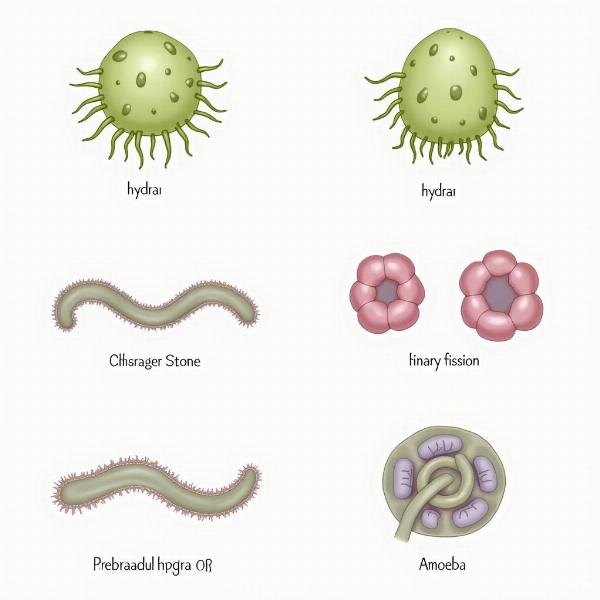Reproduction in animals, meaning “janvaro mein prasav” (जनवरों में प्रसव) or “pashu prajanan” (पशु प्रजनन) in Hindi, is the biological process by which new individual animals – “offspring” – are produced from their “parents.” This fundamental life process ensures the continuation of animal species across generations. Understanding the various methods and nuances of animal reproduction is crucial for anyone interested in biology, animal husbandry, or even simply appreciating the diversity of life on Earth.
Different Types of Animal Reproduction
Animal reproduction comes in two primary forms: sexual and asexual. Sexual reproduction, involving the combination of genetic material from two parents, is the most common type. Asexual reproduction, on the other hand, involves only one parent and produces offspring genetically identical to the parent.
Sexual Reproduction in Animals
Sexual reproduction involves the fusion of male and female gametes – sperm and egg – forming a zygote. This zygote develops into a new individual, inheriting a combination of genetic traits from both parents. This genetic diversity is a key advantage of sexual reproduction, contributing to the adaptability and resilience of animal populations.
Asexual Reproduction in Animals
Asexual reproduction allows animals to reproduce quickly without the need for a mate. Common methods include budding, fission, fragmentation, and parthenogenesis. While efficient, asexual reproduction results in less genetic diversity, potentially making the population more vulnerable to environmental changes.
 Asexual Reproduction in Animals
Asexual Reproduction in Animals
Understanding “Prasav” (प्रसव) and “Prajanan” (प्रजनन)
The Hindi word “prasav” (प्रसव) more specifically refers to the act of giving birth, particularly in mammals. While connected to reproduction, it doesn’t encompass the entire process. “Prajanan” (प्रजनन), however, has a broader meaning, encompassing the entire cycle of reproduction, from mating to the birth and development of offspring.
Factors Affecting Animal Reproduction
Various factors influence animal reproduction, including environmental conditions, hormonal changes, and the availability of resources like food and water. Understanding these factors is crucial for managing animal populations and conserving endangered species. For example, seasonal changes can trigger breeding behaviors in many animals.
Reproduction in Animals: Frequently Asked Questions
- What is the basic difference between sexual and asexual reproduction? Sexual reproduction involves two parents contributing genetic material, while asexual reproduction involves only one parent.
- Why is genetic diversity important in animal populations? Genetic diversity increases the ability of a population to adapt to changing environments and resist diseases.
- What are some examples of animals that reproduce asexually? Some examples include starfish, hydra, and certain species of lizards.
- How does the environment affect animal reproduction? Factors like temperature, food availability, and daylight hours can influence breeding seasons and reproductive success.
- What is the meaning of “janvaro mein prasav” (जनवरों में प्रसव) in English? It translates to “birth in animals” or more broadly, “reproduction in animals.”
- What is the Hindi word for breeding? “Prajanan” (प्रजनन) is the Hindi word for breeding.
- How does “prasav” (प्रसव) differ from “prajanan” (प्रजनन)? “Prasav” refers specifically to giving birth, while “prajanan” encompasses the entire reproductive process.
Conclusion
Reproduction in animals, whether sexual or asexual, is a fascinating and complex process essential for the survival of species. Understanding the various mechanisms and influencing factors is crucial for appreciating the intricacies of the natural world. From the simple division of a single cell to the elaborate courtship rituals of complex organisms, reproduction in animals showcases the remarkable diversity and adaptability of life on Earth. Knowing the Hindi terms “prasav” (प्रसव) and “prajanan” (प्रजनन) allows for a deeper understanding of these concepts within the Indian context.
Meaning-Hindi.in: Your Partner for Hindi Translations
Meaning-Hindi.in specializes in accurate and culturally sensitive Hindi translation services. Whether you need business documents, legal papers, technical manuals, or educational materials translated, our expert team provides high-quality translations tailored to your specific needs. We excel in various translation specializations, including business & commerce, legal & certified, technical & user manuals, website & localization, educational & academic, as well as express & specialized translations. For reliable Hindi translations, contact us at [email protected] or call us at +91 11-4502-7584. Meaning-Hindi.in is your trusted partner for all your Hindi translation requirements.